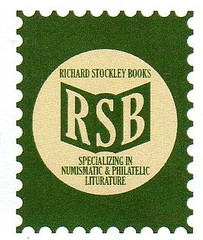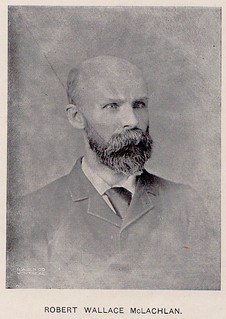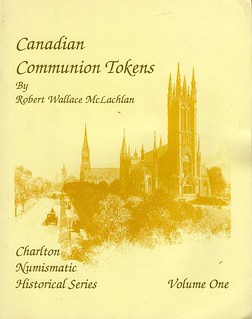
PREV ARTICLE
NEXT ARTICLE
FULL ISSUE
PREV FULL ISSUE
MCLACHLAN'S CANADIAN COMMUNION TOKENSHoward R. Engel is the proprietor of Richard Stockley Books in Winnipeg, Manitoba, Canada, specializing in numismatic and philatelic literature. He recently inaugurated a new column on literature in Bison Tales, a publication of the Manitoba Coin Club. They and Howard kindly agreed to my request to republish the articles here in The E-Sylum. Thanks for sharing this. Items discussed are generally part of Howard's stock. All readers are welcome to do the same, offering a "show-and-tell" about interesting numismatic literature items in their library, duplicate file or stock. -Editor Engel's Angle on Numismatic Literature
McLachlan also appreciated the social aspects of the numismatic hobby, becoming, in 1864, an early and very active member of the Numismatic Society of Montreal (later the Antiquarian and Numismatic Society of Montreal), sponsored by his mentor Brondson. He also was elected as one of the earliest members of the Numismatic Society of London in 1868. He became a charter member of the British Numismatic Society and a permanent member of the American Numismatic Society in 1884, after a 2-year stint as a corresponding member of the ANS from 1877-1879. McLachlan first became a member of the American Numismatic Association (ANA) in 1908, attending and presenting papers at many ANA conventions. At the Chicago Convention in 1911 he was elected as 2nd Vice-President of the ANA and became 1st Vice-President in 1913. McLachlan was inducted in the ANA Hall of Fame in 1982. By the time McLachlan turned 77 years of age in 1922, he decided that he could no longer actively manage his extensive collection and he wanted to preseve it for public education in his home city of Montreal. He thus arranged to transfer ownership (partially by donation and partially by sale) of his collection of 20,000 pieces (including the most complete collection of Canadian numismatics amassed to that time), plus his numismatic library consisting of 500 books and 5,000 pamphlets to the Antiquarian and Numismatic Society of Montreal to reside in the home of the Society at the Chateau de Ramezay museum for generations to come. The Bank of Canada purchased the McLachlan Collection from Chateau de Ramezay in 1974 but this did not include his numismatic library, which was sold to a private collector in 1984 and was later dispersed in at least four George Kolbe numismatic auctions in the 1990s. As a pioneer Canadian numismatic giant, McLachlan would not only subscribe to the adage of subsequent generations, "Buy the book before you buy the coin", he effectively communicated by his extensive numisatic research "Write the book about the coin"! His "home club", the Antiquarian and Numismatic Society of Montreal published his many articles in their journal, beginning with the first issue in 1872 with the article "A Plea for Artistic Coinage". Over the years many of his articles were reprinted as a testimony to their quality and authority in the field. Notable examples include "'Canadian Temperance Medals", "Money and Medals of the Old Regime in Canada", "The Louisburg Medals", "The Card Money of Canada" and "Canadian Communion Tokens". The last example on the aforementioned list of McLachlan's prolific numismatic publications is the focus of this column's work of numismatic literature. Communion tokens were a way some churches (most notably, in the Canadian colonies, those of the Calvinist tradition later known, after the union of 1875, as the Presbyterian Church in Canada) to identify their own worthy communing members. They were issued in the base metal of the day (white metal, pewter and later issues in aluminum). In the Calvinist tradition, communion was celebrated only a couple of times a year and required much preparation and anticipation among the faithful. Parishioners would arrive on Wednesday for the Communion event that began on Thursday and culminated with the celebration of Holy Communion on the Sunday. The tokens were distributed on Saturday night by the minister in charge to deserving members who then would submit them at the time of communion the following day. Tokens would typically include the name or initials of the Church and its community, the year of issue and an appropriate Bible verse on the reverse, such as "This do in remembrance of me" (I Corinthians 11:24), In terms of their shape they were typically square, rectangular, or oblong, seldom round, presumably since the need for text was more easily accomplished on non-round shapes. Later stock tokens would sometimes replace the name of the parish and date of issue with another Bible verse, like "Let a man examine himself." (I Corinthians 11: 28). Others might include an image of the Communion table, for instance. The earliest communion token in the Canadian colonies of British North America was issued by the Assoicate Presbytery in Truro, Nova Scotia in 1772. Just over a century later, in 1876, the newly formed Presbyterian Church in Canada probably issued the last communion token with the name of an individual parish, in this case Old St. Andrew's Church in Toronto, Ont. According to Warren Baker, most churches that had used parish-specific tokens had opted for stock tokens and the much less expensive cardboard tickets beginning in the 1860s. Thus, by the time McLachlan produced his treatise on Canadian Communion Tokens in 1891 and assign his own numbering system to them, the series was complete and ripe for a comprehensive treatment that only a numismatist of McLachlan's caliber could give. In recognition of McLachlan's numismatic research and service in the Royal Society of Canada (RSC), including many years as the official Antiquarian and Numismatic Society delegate to RSC meetings, in 1911 he was elected as a member of the prestigious and exclusive RSC. This entitled McLachlan to the rare privilege of using the initials F.R.S.C. after his name. Original copies of the 1891 reprint are rare. I have the following in stock for numismatic bibliophiles who prefer original editions of Canadian numismatic pioneers: McLachlan, Robert Wallace. Canadian Communion Tokens: a Catalogue of Metal Sacramental Tickets Used in the Different Presbyterian Churches in Canada. Montreal: William Drysdale, 1891. 62 p., original paper stapled covers, front cover loose, chipped, pages yellowed and paper extremely brittle, archival copy, $80. The following is the most common reprint, excellent for research purposes: McLachlan, Robert Wallace. Canadian Communion Tokens: a Catalogue of Metal Sacramental Tickets Used in the Different Presbyterian Churches in Canada. (Charlton Numismatic Historical Series, vol. 1) Toronto: Charlton 1991 reprint. (4), 62, (2) pages, original printed card covers,bumped on right side and slightly creased at lower right. $20. As contemporary numismatic research luminary and the 2019 recipient of Canada's top numismatic award, the J. Douglas Ferguson Medal, Stanley Clute observes, "'It is not unfair to state McLachlan left behind him a legacy of numismatic research and writing which helped in large measure to lay the groundwork for today's researchers into early Canadian numismatics.'" to which I say, "Amen!" References: Atchison, Darryl, ed. Canadian Numismatic Bibliography. The Numismatic Education Society of Canada, 2007, p. 412 (reference to McLachlan's series of articles on Canadian communion tokens originally published in the Canadian Antiquarian and Numismatic Journal). Atchison, Darryl. "Robert Wallace McLachlan (1845-1926)" Newman Numismatic Portal (https://nnp.wustl.edu/library/periodical/627777, accessed Jan. 15, 2021) The Charlton Standard Catalogue of Candian Communion Tokens. 1st ed. Toronto: The Charlton Press, 1992, p. ix & x (Warren Baker's introduction), p. 81 (Truro, first token, 1772) p. 239 (Toronto - Old St. Andrew's Church latest name-parish token, 1876), p. 259 (stock token with inscription and altar/communion table design), p. 261 (stock token with inscription on obverse and reverse) "Obituary: Robert Wallace McLachlan". The Numismatist. Vol. 39 no. 6, June 1926, p. 290-293. Robitaille, Jesse. "Early Canadian Numismatists gave hobby life". Canadian Coin News. Vol. 58 no. 15, Oct. 27-Nov. 9, 2020, p. 1 (quote by Stanley Clute). Thanks, Howard! Readers can reach him at 204-253-0419 or by email at richardstockleybooks@mymts.net. -Editor THE BOOK BAZARREWayne Homren, Editor The Numismatic Bibliomania Society is a non-profit organization promoting numismatic literature. See our web site at coinbooks.org. To submit items for publication in The E-Sylum, write to the Editor at this address: whomren@gmail.com To subscribe go to: https://my.binhost.com/lists/listinfo/esylum All Rights Reserved. NBS Home Page Contact the NBS webmaster 
|



